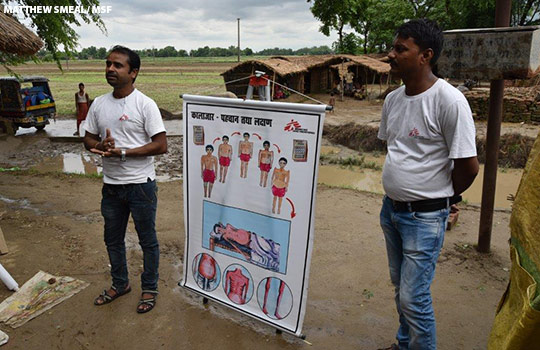Julien Potet on the next steps we need to take in the fight against neglected tropical diseases
 This week scientists, policy makers, and other global health actors met in Geneva for a summit on neglected tropical diseases (NTDs). These are a group of diseases that overwhelmingly affect the poorest of the poor in low and middle income countries, but that have long been vastly underfunded and under-researched.
This week scientists, policy makers, and other global health actors met in Geneva for a summit on neglected tropical diseases (NTDs). These are a group of diseases that overwhelmingly affect the poorest of the poor in low and middle income countries, but that have long been vastly underfunded and under-researched.
The summit’s objective: to assess progress and plans five years after the World Health Organization (WHO) launched both a roadmap aimed at combatting NTDs and a public-private partnership (the “London Declaration”), which would help implement the roadmap by mobilising funding, along with drug donations from pharmaceutical corporations.
The summit is an opportunity to celebrate some substantial achievements—especially on the roadmap’s clear targets for reducing new cases by 2020. It’s also an opportunity to acknowledge and address the gaps, in particular that millions of people around the word today who have these diseases still lack access to the medicines, diagnostics, and care they desperately need.
One emergent success story is a substantial reduction in human African trypanosomiasis (sleeping sickness) cases. The late 1990s saw an estimated 300 000 annual deaths; in 2015, fewer than 3000 cases were reported to WHO. An important caveat is that we can’t let our guard down now and risk another resurgence. Until the 1960s, systematic and active case finding and treatment kept sleeping sickness under control, but a lack of continued surveillance and control—due partly to political instability in some highly affected countries—led to a considerable rebound in the 1980s and 1990s.
Looking ahead, adapted approaches will be crucial to avoiding a repeat scenario. These efforts should be helped by new diagnostic tests and oral drugs becoming available very soon from the development pipeline of the Drugs for Neglected Diseases initiative (DNDi) and other product development partnerships, which will simplify case detection and management.
To address the major challenges still ahead on the path to curbing NTDs, stakeholders at this year’s summit should take action to:
• Recommend that WHO’s priority list of NTDs becomes dynamic rather than fixed, so that new diseases can be added and attention shifted according to patient needs. The roadmap’s focus on reducing or even eliminating disease excludes some important NTDs from the programme. For example, NTDs such as snakebite or noma cannot be eliminated, kill tens of thousands of people in poor rural communities each year, and yet are not on the roadmap’s list—which contributes to their being overlooked by actors who could help curb them.
A focus on neglected patients, rather than on a specific disease, should help in identifying and addressing new disease surges, and if necessary shift support from diseases that have receded. The recent clarification of NTD classification criteria by WHO paves the way for this type of dynamic approach.
• Enhance support to programmes providing care and treatment for people with NTDs. While prevention is the goal, it is not always possible—so expanding access to proper diagnosis, care, and treatment for people with NTDs remains crucial. For example, while the number of new Chagas disease cases in Latin America has decreased after intensified vector control activities, less than 1% of the estimated six million people with chronic Chagas disease have access to diagnosis and treatment.
Another example is visceral leishmaniasis, which continues to thrive in India and in East Africa, especially among people who are displaced and malnourished. Since the instability and violence driving the latter is unlikely to improve any time soon, it is essential to improve access to appropriate healthcare and existing medicines, and to accelerate the development of more diagnostic tests and medicines that are adapted to the context.

• Develop access policies for NTD diagnostics and drugs that do not fit a donation based solution. While pharmaceutical company donations have helped curb NTDs, this approach isn’t always possible or optimal. A large company like Sanofi has been able to donate drugs for sleeping sickness for over 15 years, but this is not an option for NTD drugs like paromomycin or miltefosine (for visceral leishmaniasis) that are manufactured by small pharmaceutical companies with far less capacity. Given the limited market size, these life saving drugs are often produced only for orders above a minimum volume—a practice that can lead to shortages.
Another constant concern is that manufacturers may cease production due to market instability. The fact that several critical NTD tests have been manufactured and commercialised for decades only by not-for-profit research institutes demonstrates that companies do not consider these markets as viable investments. For these and other situations unlikely to be resolved by donations, alternative policies based on better collaborations between procurers and suppliers are urgently needed.
• International partners must continue to support NTD initiatives, and endemic countries must increase political commitment, including domestic funding. While the UK government just announced that it will double its funding to NTDs, the US is considering cuts to relevant global health programmes in its proposed budget. Endemic countries, which are primarily in the driving seat, must step up resources to fight NTDs. Support for strengthening general healthcare systems, surveillance, and outbreak responsiveness in low and middle income countries—especially in rural settings—is also crucial.
Julien Potet is the Paris based NTD policy adviser at the Access Campaign, Doctors Without Borders/Médecins Sans Frontières.
Competing interests: None declared.
